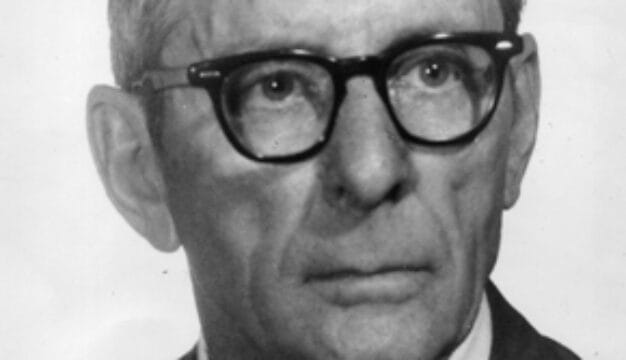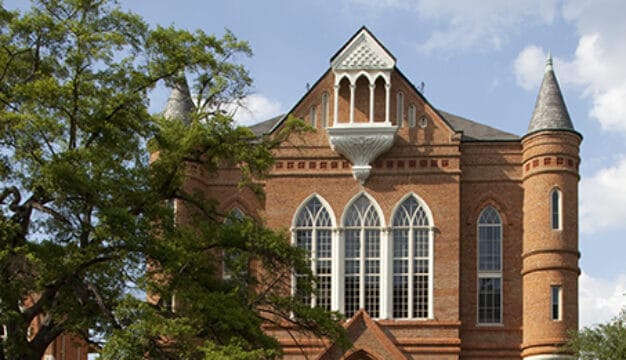Talladega
 Historic Ritz Theatre in Talladega
Located in the northeast central part of Alabama, approximately 50 miles east of Birmingham, the city of Talladega was incorporated in 1835, just two years after the creation of Talladega County. The Creek village Talatigi was located near the site before white settlement. As settlers began to move into the area, the name gradually evolved into Talladega. The city has always been the county seat of Talladega County. It is home to one of the nation’s most comprehensive educational programs for the deaf and blind, to Alabama’s oldest private historically black liberal arts college, and to the Talladega Superspeedway. The city has a mayor-council form of government, with a five-member elected city council. In 2019, the city’s citizens elected their first African American mayor, Timothy Ragland.
Historic Ritz Theatre in Talladega
Located in the northeast central part of Alabama, approximately 50 miles east of Birmingham, the city of Talladega was incorporated in 1835, just two years after the creation of Talladega County. The Creek village Talatigi was located near the site before white settlement. As settlers began to move into the area, the name gradually evolved into Talladega. The city has always been the county seat of Talladega County. It is home to one of the nation’s most comprehensive educational programs for the deaf and blind, to Alabama’s oldest private historically black liberal arts college, and to the Talladega Superspeedway. The city has a mayor-council form of government, with a five-member elected city council. In 2019, the city’s citizens elected their first African American mayor, Timothy Ragland.
Early History
Gen. Andrew Jackson’s victories over the Red Stick Creeks at the Battle of Talladega and the subsequent Battle of Horseshoe Bend opened eastern and central Alabama to white settlement. The area officially remained Creek territory until the signing of the Treaty of Cusseta in 1832. In January 1834, lands were advertised for sale at a new government land office opened at Mardisville, just south of present-day Talladega. The Treaty of Cusseta specifically granted a half section of land to an African American man, Joseph Bruner, in recognition for his services as an interpreter. Bruner soon sold this tract to a local man, Jesse Duran. In July 1834, Duran donated the tract for a town site, with the proviso that he and his partner would receive a portion of the monies from the public sales. Six months later on January 9, 1835, the Alabama Legislature incorporated the town of Talladega.
Shortly after incorporation, Talladega began to grow with the construction of log houses, taverns, trading posts, hotels, and churches. As a result, the town was chosen by just one vote as the site for the county courthouse, making Talladega the county seat. In February 1836, a special tax was imposed on activities related to gambling, such as racetracks, racehorses, billiard tables, and card playing, to finance construction of the courthouse, which was completed in 1838. Despite being damaged by a tornado and then a fire, it is the oldest courthouse in continuous use in Alabama.
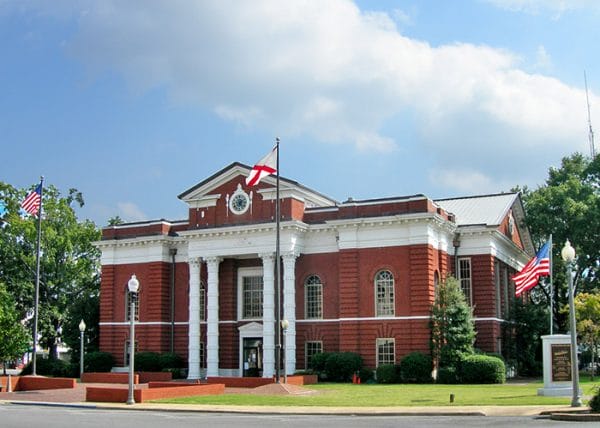 Talladega County Courthouse
When the courthouse was completed, Talladega began attracting lawyers, merchants, doctors, teachers, and preachers as new residents. It also became home, in 1858, to the first school for the blind in the state, now the Alabama Institute for the Deaf and Blind. Most of the area’s inhabitants were involved in farming, with 39 percent of the county’s population consisting of enslaved people. Despite the number of slave-holding plantations in the surrounding area, Talladegans were about evenly divided on the issue of secession from the United States. Nevertheless, when the Civil War began, the divergent groups came together to form a company of troops referred to as the Talladega (or Alabama) Rifles. Talladega further supported the war effort by providing uniforms, a nitre works, a hospital for the wounded, and a prison for federal soldiers.
Talladega County Courthouse
When the courthouse was completed, Talladega began attracting lawyers, merchants, doctors, teachers, and preachers as new residents. It also became home, in 1858, to the first school for the blind in the state, now the Alabama Institute for the Deaf and Blind. Most of the area’s inhabitants were involved in farming, with 39 percent of the county’s population consisting of enslaved people. Despite the number of slave-holding plantations in the surrounding area, Talladegans were about evenly divided on the issue of secession from the United States. Nevertheless, when the Civil War began, the divergent groups came together to form a company of troops referred to as the Talladega (or Alabama) Rifles. Talladega further supported the war effort by providing uniforms, a nitre works, a hospital for the wounded, and a prison for federal soldiers.
In July 1864, Talladega was invaded by U.S. Army forces under the command of Gen. Lovell H. Rousseau, whose mission in Alabama was to destroy the Montgomery and West Point Railroad that was carrying supplies to Confederate troops in Atlanta. His forces burned the railroad depot in Talladega and inflicted considerable damage on Confederate stores within the area. Talladega was hit again two weeks after Gen. Robert E. Lee’s surrender at Appomattox Court House, when Gen. John T. Croxton led the last of Wilson’s Raiders into Talladega, burning buildings and pillaging stores. A local judge saved the town from total destruction by approaching Croxton with a Masonic sign and pleading mercy for the remainder of the community.
Demographics
According to 2020 Census estimates, Talladega recorded a population of 15,793. Of that number, 51.0 percent identified themselves as African American, 46.2 percent as white, 5.0 percent as Hispanic, 1.6 percent as two or more races, 0.4 percent as American Indian, 0.2 percent as Asian, and 0.2 as Native Hawaiian and Other Pacific Islander. The city’s median household income was $30,088, and per capita income was $18,283.
Economic Development
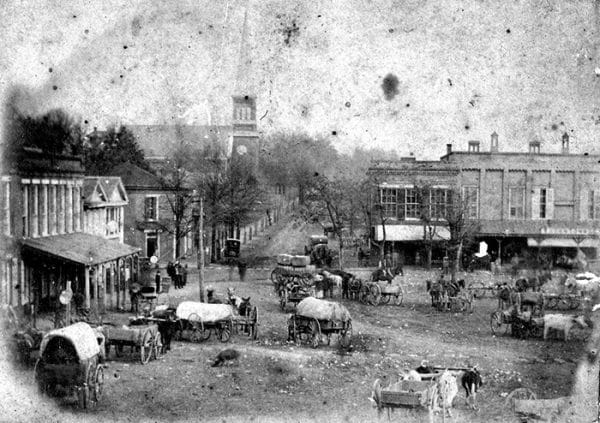 Talladega, 1875
Talladega’s economy was in ruins following the Civil War, and many of its citizens moved on, mostly to the expanding frontier of the West. Those who stayed survived by operating small farms. The economy was gradually stimulated by the development of iron foundries (such as Clifton Iron Company, owned by Horace Ware and Samuel Noble), marble quarries, and textile mills. By 1885, although the economy had vastly improved, Talladega still had the reputation of a lawless community. Outsiders terrified local citizens by storming into town on horseback with their pistols ablaze. Mayor William H. Skaggs, who took office in 1885, quickly brought this situation under control by installing a new police force and establishing law and order. During Skaggs’s reign as mayor, he also stimulated the local economy by improving the streets, building a water-works system, opening a prison, and establishing a public school system.
Talladega, 1875
Talladega’s economy was in ruins following the Civil War, and many of its citizens moved on, mostly to the expanding frontier of the West. Those who stayed survived by operating small farms. The economy was gradually stimulated by the development of iron foundries (such as Clifton Iron Company, owned by Horace Ware and Samuel Noble), marble quarries, and textile mills. By 1885, although the economy had vastly improved, Talladega still had the reputation of a lawless community. Outsiders terrified local citizens by storming into town on horseback with their pistols ablaze. Mayor William H. Skaggs, who took office in 1885, quickly brought this situation under control by installing a new police force and establishing law and order. During Skaggs’s reign as mayor, he also stimulated the local economy by improving the streets, building a water-works system, opening a prison, and establishing a public school system.
 Jemison-Carnegie Heritage Hall Museum
During the first half of the twentieth century, Talladega continued its economic growth by building more textile mills, foundries, and other plants. The founding of the Bemis Bag Company, which manufactured cotton sacks, resulted in the development of an entire new community called Bemiston. World War II saw the rapid creation of wartime plants, particularly in the Brecon area on the outskirts of the city. These industries helped to increase population, which in turn, increased the number of schools and churches in the community and created new opportunities for recreation and entertainment. In 1968, construction began on the Talladega Superspeedway just a few miles out of town just off of Interstate 20. Today, the facility seats more than 140,000 NASCAR fans and is home to two of NASCAR’s top-tier Sprint Cup Series races each year (the Aaron’s 499 and the Amp Energy 500).
Jemison-Carnegie Heritage Hall Museum
During the first half of the twentieth century, Talladega continued its economic growth by building more textile mills, foundries, and other plants. The founding of the Bemis Bag Company, which manufactured cotton sacks, resulted in the development of an entire new community called Bemiston. World War II saw the rapid creation of wartime plants, particularly in the Brecon area on the outskirts of the city. These industries helped to increase population, which in turn, increased the number of schools and churches in the community and created new opportunities for recreation and entertainment. In 1968, construction began on the Talladega Superspeedway just a few miles out of town just off of Interstate 20. Today, the facility seats more than 140,000 NASCAR fans and is home to two of NASCAR’s top-tier Sprint Cup Series races each year (the Aaron’s 499 and the Amp Energy 500).
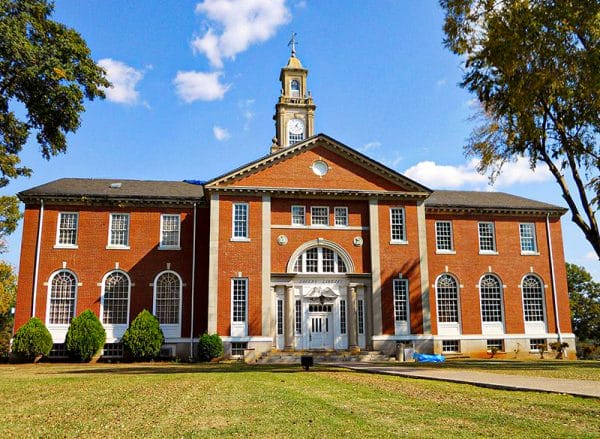 Talladega College
In the latter part of the twentieth century, Talladega experienced much social, political, and economic change. The most profound social and political changes involved the empowerment of Talladega’s African American population. Economically, the most dramatic change involved the shift from locally owned businesses to shopping centers and chain stores. However, the town continues to succeed because of new industries, such as Georgia-Pacific Corporation, and the continued draw of local institutions such as the Alabama Institute for the Deaf and Blind and Talladega College. The opening of a Honda manufacturing plant in nearby Lincoln has provided an economic boost to the surrounding communities, including Talladega.
Talladega College
In the latter part of the twentieth century, Talladega experienced much social, political, and economic change. The most profound social and political changes involved the empowerment of Talladega’s African American population. Economically, the most dramatic change involved the shift from locally owned businesses to shopping centers and chain stores. However, the town continues to succeed because of new industries, such as Georgia-Pacific Corporation, and the continued draw of local institutions such as the Alabama Institute for the Deaf and Blind and Talladega College. The opening of a Honda manufacturing plant in nearby Lincoln has provided an economic boost to the surrounding communities, including Talladega.
Employment
According to 2020 Census estimates, the workforce in Talladega was divided among the following industrial categories:
- Manufacturing (25.5 percent)
- Educational services, and health care and social assistance (25.3 percent)
- Retail trade (11.6 percent)
- Public administration (7.9 percent)
- Construction (7.0 percent)
- Arts, entertainment, recreation, accommodation, and food services (5.7 percent)
- Other services, except public administration (5.3 percent)
- Transportation and warehousing and utilities (3.0 percent)
- Wholesale trade (2.5 percent)
- Professional, scientific, management, and administrative and waste management services (2.3 percent)
- Finance, insurance, and real estate, rental, and leasing (2.2 percent)
- Agriculture, forestry, fishing and hunting, and extractive (1.7 percent)
Education
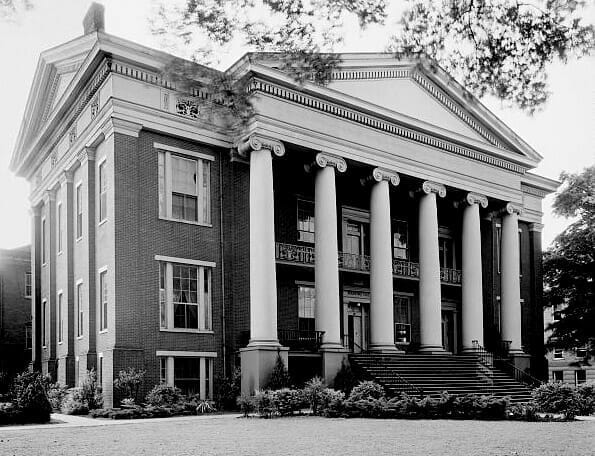 Manning Hall, AIDB
The Talladega City School System oversees nine schools. Post-secondary opportunities are also available in Talladega at Talladega College, Alabama’s oldest private historically black liberal arts college, founded by former slaves William Savery and Thomas Tarrant of Talladega. The Alabama Institute for Deaf and Blind (AIDB), established in 1858, is also headquartered there.
Manning Hall, AIDB
The Talladega City School System oversees nine schools. Post-secondary opportunities are also available in Talladega at Talladega College, Alabama’s oldest private historically black liberal arts college, founded by former slaves William Savery and Thomas Tarrant of Talladega. The Alabama Institute for Deaf and Blind (AIDB), established in 1858, is also headquartered there.
Transportation
State Highway 77, a modern four-lane highway, connects the city of Talladega with Interstate I-20, giving it easy access to the Birmingham and Atlanta airports. Talladega Municipal Airport has a 6,000-foot runway that accommodates private jets and other medium-sized aircraft. It averages more than 100 flights per day.
Events and Places of Interest
 Talladega Superspeedway
Talladega’s town square epitomizes the ideal of small-town America. Its Ritz Theatre, located on the square, is considered one of the best surviving examples of the Art Deco theatres of the 1930s. Today, this theater hosts such events as actor Hal Holbrook’s one-man show, “Mark Twain Tonight.” The city’s “April in Talladega” pilgrimage attracts visitors to tour antebellum and turn-of-the-century homes in Talladega’s Silk Stocking District. The Jemison-Carnegie Heritage Hall Museum exhibits works by nationally and locally recognized artists. Davey Allison Memorial Park celebrates the life and racing career of NASCAR star Davey Allison, who was killed in a helicopter crash at the Talladega Superspeedway at the age of 32. Nearby attractions include the Talladega National Forest; Cheaha State Park, a retreat at the highest point in Alabama; Majestic Caverns Park, with more than 20 attractions; Talladega Superspeedway, NASCAR’s fastest motorsports facility; and the International Motor Sports Hall of Fame.
Talladega Superspeedway
Talladega’s town square epitomizes the ideal of small-town America. Its Ritz Theatre, located on the square, is considered one of the best surviving examples of the Art Deco theatres of the 1930s. Today, this theater hosts such events as actor Hal Holbrook’s one-man show, “Mark Twain Tonight.” The city’s “April in Talladega” pilgrimage attracts visitors to tour antebellum and turn-of-the-century homes in Talladega’s Silk Stocking District. The Jemison-Carnegie Heritage Hall Museum exhibits works by nationally and locally recognized artists. Davey Allison Memorial Park celebrates the life and racing career of NASCAR star Davey Allison, who was killed in a helicopter crash at the Talladega Superspeedway at the age of 32. Nearby attractions include the Talladega National Forest; Cheaha State Park, a retreat at the highest point in Alabama; Majestic Caverns Park, with more than 20 attractions; Talladega Superspeedway, NASCAR’s fastest motorsports facility; and the International Motor Sports Hall of Fame.
Further Reading
- The Heritage of Talladega County, Alabama. Clanton, Ala.: Heritage Publishing Consultants, 2000.
- White, Walter Belt. Talladega: Pathways to the Past. Images of America series. Charleston, S.C.: Arcadia Publishing, 2003.

